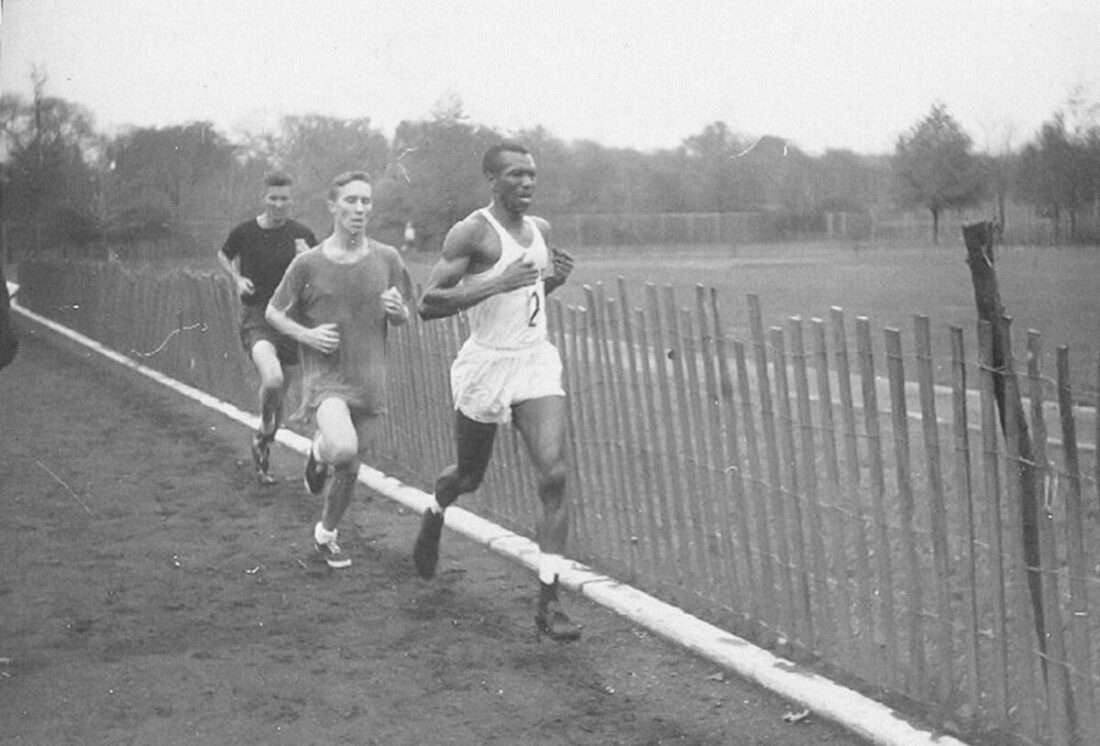The grandson of enslaved parents, Ted Corbitt (1919-2007) was born on a cotton farm near Dunbarton, South Carolina, USA. He recalls a childhood of running for pleasure and for the sheer necessity of getting around. Corbitt ran track events in high school and later at the University of Cincinnati. Surrounded by racism, he was often banned from track meets when white athletes refused to compete against him. And he was rarely able to stay in the same lodgings while traveling for competitions.
Following army service in World War II, Corbitt earned a graduate degree in physical therapy from New York University, where he later lectured. He began his professional career at the height of the polio epidemic at the Institute for the Crippled and Disabled in Manhattan, and remained there for 43 years.
As a teen, Corbitt had learned of Ellison Myers Brown, a Native American who won the Boston Marathon in 1936 and 1939. It motivated him to see if he could run as far and he eventually became a world-class marathon and ultra long-distance runner who enjoyed an extraordinarily long career. In the Boston Marathon, for example, his first race was in 1951 and his last race in 1974. In total he ran 199 marathons, winning 30 of them, and also competed in many ultramarathons of 50 miles or more. Corbitt competed in the 1952 Helsinki Olympic Games, as the first African American to represent the United States in the marathon.
Running in the streets of 1950’s America, when fitness ‘joggers’ were not yet common he was a true pioneer of the sport.
In 1955, at the age of 35, he ran his daily 13-mile commute from the Bronx to his job at the Institute in Manhattan. Corbitt said, “You have to watch yourself in traffic; you can only afford one misstep.” But there were always other things to watch out for too. Corbitt told friends he had been stopped 300 times by police.
Corbitt was a lifelong learner, using himself as a subject for physical therapy, physiology, nutrition, and running experimentation. He once wore a portable EKG monitor during a race so that the impact on his heart could be studied later. His findings helped to elevate his own running performance and to advance his knowledge as a therapist for the benefit of his patients. Corbitt was a pioneer of high-volume training of 200 and 300 miles per week, which prepared him for world-class results in major competitions.
But Corbitt’s contribution to running extended beyond competing. He founded and served as an unpaid official of many running organisations. He helped plan the New York City Marathon course and created the master division for runners over 40. In the early 1960’s he facilitated the adoption of precision measurement and certification of road race courses in the United States.
Corbitt’s running distances and longevity were extraordinary, ultimately running over 200,000 miles, equivalent to eight times around the world. In 2003, at 84 years of age, he completed a 24-hour race, walking 68 miles and finishing 17th. He continued volunteering at ultramarathon events at 87, and sometimes competing. And throughout, he continued to treat physiotherapy patients.
References
Cherns T. 1988. Ted Corbitt: An ultrarunning pioneer. Ultrarunning. Accessed online at https://archive.ph/20130205072727/http://www.ultrarunning.com/ultra/features/profiles/ted-corbitt-an-ultrarunni.shtm on 2 June 2022.
Eversley, M. 2017. Olympic marathoner Ted Corbitt remembered 10 years after his death. NBC News. Accessed online at https://www.nbcnews.com/news/nbcblk/long-distance-runner-ted-corbitt-remembered-10-years-after-his-n828301 on 14 June 2022.
O’Donnell K. 2022. Inspirational athletes from history: How Ted Corbitt used his running career to help those in need of physical therapy. The Epoch Times. Accessed online at https://www.theepochtimes.com/inspirational-athletes-from-history-how-ted-corbitt-used-his-running-career-to-help-those-in-need-of-physical-therapy_4486562.html?slsuccess=1 on 2 June 2022.


Thank you. Wonderful story.